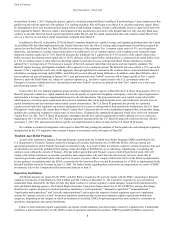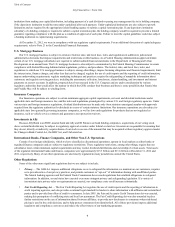Ally Bank 2012 Annual Report Download - page 20
Download and view the complete annual report
Please find page 20 of the 2012 Ally Bank annual report below. You can navigate through the pages in the report by either clicking on the pages listed below, or by using the keyword search tool below to find specific information within the annual report.18
7, 2013 the Examiner informed the Bankruptcy Court in the third supplement to the work plan that the investigation and related report will not
be completed until early May 2013.
On December 26, 2012, the Bankruptcy Court, in an effort to facilitate plan negotiations, entered an order appointing bankruptcy judge
James M. Peck, Esq. as mediator to assist the parties in resolving certain issues relating to the formulation and confirmation of the Plan. There
can be no assurance that the mediation process will continue or will ultimately lead to a successful agreement among the parties.
On February 26, 2013, the official committee of unsecured creditors appointed in the Debtors' bankruptcy cases (the Creditors'
Committee) filed with the Bankruptcy Court a response to the Debtors' motions for appointment of a chief restructuring officer and to extend
their exclusive period to file a chapter 11 plan, which, among other things, states that the Creditors' Committee supports such extension
through and including April 30, 2013, and during such time the Creditors' Committee will agree not to bring any claims against AFI. The
response further states that the Debtors consent to the Creditors' Committee seeking standing in the Bankruptcy Court to prosecute and/or
settle the Debtors' alleged claims against AFI and agree to settle claims against AFI only with Creditors' Committee consent.
On February 27, 2013, the Debtors filed a motion with the Bankruptcy Court seeking, for purposes of any proposed chapter 11 plan, that
GMAC Mortgage's obligation to conduct and pay for independent file review regarding certain residential foreclosure actions and foreclosure
sales prosecuted by GMAC Mortgage and its subsidiaries, as required under the Consent Order, be classified as a general unsecured claim in
an amount to be determined, and that the automatic stay under the Bankruptcy Code be applied to prevent the FRB, the FDIC, and other
governmental entities from taking any action to enforce the obligation against the Debtors. If the Bankruptcy Court approves the motion, such
governmental entities are likely to seek to enforce the obligation against AFI, and any such obligations ultimately borne by AFI could be
material. The Debtors have requested that the motion be heard at a hearing on March 21, 2013.
We are currently named as defendants in various lawsuits relating to ResCap mortgage-backed securities and certain other mortgage-
related matters, which are described in more detail in Note 29 to the Consolidated Financial Statements. The majority of these matters are
currently subject to orders entered by the Bankruptcy Court staying the matters through either March 31, 2012 or April 30, 2013. Unless the
Debtors seek and obtain Bankruptcy Court approval to extend these stay orders, these matters are expected to proceed against us once the
applicable stay orders expire.
As a result of the termination of the Settlement, AFI is no longer obligated to make the $750 million cash contribution and neither party
is bound by the Settlement. Further, AFI is not entitled to receive any releases from either the Debtors or any third party claimants, as was
contemplated under the Plan and Settlement. However, AFI has not withdrawn its offer to provide a $750 million cash contribution to the
Debtors' estate if an acceptable settlement can be reached. As a result of the termination of the Settlement, substantial claims could be brought
against us, which could have a material adverse impact on our results of operations, financial position or cash flows.
We are exposed to consumer credit risk, which could adversely affect our profitability and financial condition.
We are subject to credit risk resulting from defaults in payment or performance by customers for our contracts and loans, as well as
contracts and loans that are securitized and in which we retain a residual interest. Furthermore, a weak economic environment and high
unemployment rates could exert pressure on our consumer automotive finance customers resulting in higher delinquencies, repossessions, and
losses. There can be no assurances that our monitoring of our credit risk as it affects the value of these assets and our efforts to mitigate credit
risk through our risk-based pricing, appropriate underwriting policies, and loss-mitigation strategies are, or will be, sufficient to prevent a
further adverse effect on our profitability and financial condition. We have begun to increase our nonprime automobile financing. We define
nonprime consumer automobile loans as those loans with a FICO score (or an equivalent score) at origination of less than 620. In addition, we
have increased our used automobile financing. Borrowers that finance used vehicles tend to have lower FICO scores as compared to new
vehicle borrowers, and defaults resulting from vehicle breakdowns are more likely to occur with used vehicles as compared to new vehicles
that are financed. At December 31, 2012, the carrying value of our Automotive Finance operations nonprime consumer automobile loans
before allowance for loan losses was $5.1 billion, or approximately 9.4% of our total consumer automobile loans. Of these loans, $62 million
were considered nonperforming as they had been placed on nonaccrual status in accordance with internal loan policies. Refer to the
Nonaccrual Loans section of Note 1 to the Consolidated Financial Statements for additional information. As we grow our nonprime
automobile financing loans over time, our credit risk may increase. As part of the underwriting process, we rely heavily upon information
supplied by third parties. If any of this information is intentionally or negligently misrepresented and the misrepresentation is not detected
before completing the transaction, the credit risk associated with the transaction may be increased.
General business and economic conditions may significantly and adversely affect our revenues, profitability, and financial condition.
Our business and earnings are sensitive to general business and economic conditions in the United States. A downturn in economic
conditions resulting in increased short and long term interest rates, inflation, fluctuations in the debt capital markets, unemployment rates,
consumer and commercial bankruptcy filings, or a decline in the strength of national and local economies and other factors that negatively
affect household incomes could decrease demand for our financing products and increase financing delinquency and losses on our customer
and dealer financing operations. We have been negatively affected due to the significant stress in the residential real estate and related capital
markets and, in particular, the lack of home price appreciation in many markets in which we lend. Further, a significant and sustained increase
in fuel prices could lead to diminished new and used vehicle purchases and negatively affect our automotive finance business.
If the rate of inflation were to increase, or if the debt capital markets or the economies of the United States were to weaken, or if home
prices or new and used vehicle purchases experience declines, we could be significantly and adversely affected, and it could become more
Table of Contents
Ally Financial Inc. • Form 10-K
























